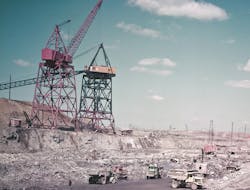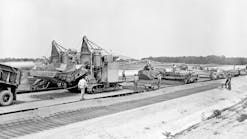In the mid- and late-1950s, the St. Lawrence River, in the vicinity of Massena, N.Y., was an epicenter of heavy construction activity. The river was being developed to allow ocean-going ships access to the Great Lakes. Contractors built a dam and separate power plant on the main channels of the river, along with 11 miles of levees, and excavated a 3.5-mile channel that connected two of the locks. Upstream, near Iroquois, Quebec, another dam, lock, and ship channel were constructed in conjunction with other work.
The statistics for all this work are astounding. The 13 contracts for which this writer has information involved more than 55,000,000 cubic yards of excavation, often in very difficult riverbed and glacial material, and placing almost 1,400,000 cubic yards of concrete. An additional contract was let for the production of approximately 3,000,000 cubic yards of aggregates for the project.
An incomplete list of equipment used included 26 large shovels and cranes, including a half dozen Manitowoc 4500 6-yard machines and four Bucyrus-Erie electric shovels; three walking draglines; nine whirley cranes; 33 motor scrapers; more than 160 Euclid 22-ton end dumps; and a fleet of 162 Euclid bottom-dump trucks ranging in capacity from 13 to 25 cubic yards. Euclid ran advertising in the late 1950s touting the popularity of its equipment on the Seaway; additional Euclids included TC-12 crawler tractors, various motor scrapers, and trucks built from R-22 haulers and TDT tractors that were used to haul concrete buckets between batch plants and cranes.
Six contracts—the Barnhart Island power plant, Long Sault Dam, Dwight D. Eisenhower and Grass River locks, and two sections of ship channel—were constructed by Peter Kiewit Sons Co., Morrison-Knudsen Co., Perini Corp., Utah Construction Co., and Walsh Construction Co. in various combinations. All five partners worked on three of the projects, and Kiewit also built the Iroquois Dam with other partners.
In the accompanying photo, foundation excavation is well underway for the Barnhart Island Power Plant. Two shovels—apparently 2.5-cubic-yard Northwest 80-D models—are visible, one at the floor of the excavation and another on the bench above. Several Euclid 22-ton R-22 haulers, equipped with radiator guards, are gathered around the working shovel, and a large drill, believed to be a Joy TWM5, is at work above the pit. The most prominent machines are two of the four Washington Iron Works whirley cranes on the project; one is being used to assemble the other.
The Barnhart Island Power Plant is now the Moses-Saunders Power Dam, named for Robert Moses and Robert H. Saunders, respective chairmen of the New York Power Authority and Ontario Hydro. The two men oversaw construction of the vast project. For all the tremendous work involved, the finished structures might not be as physically imposing as, for instance, the Hoover or Three Gorges dams. The outward dimensions of a completed construction project do not always adequately reflect the spectacle and difficulty of the work involved.
The Historical Construction Equipment Association (HCEA) is a 501(c)3 non-profit organization dedicated to preserving the history of the construction, dredging, and surface-mining equipment industries. With more than 4,000 members in 25 countries, our activities include publication of a quarterly educational magazine, Equipment Echoes; operation of the National Construction Equipment Museum and archives in Bowling Green, Ohio; and hosting an annual working exhibition of restored construction equipment. The 2017 show will be November 3-5 at the Ederville Train and Tractor Show, Carthage, N.C. Individual memberships within the USA and Canada are $35 for one year, $66.95 for two years, $99.95 for three years, and $45.00 US elsewhere. We seek to develop relationships in the equipment manufacturing industry, and we offer a college scholarship for engineering and construction management students. Information is available at www.hcea.net, or by calling 419.352.5616 or e-mailing info@hcea.net.





